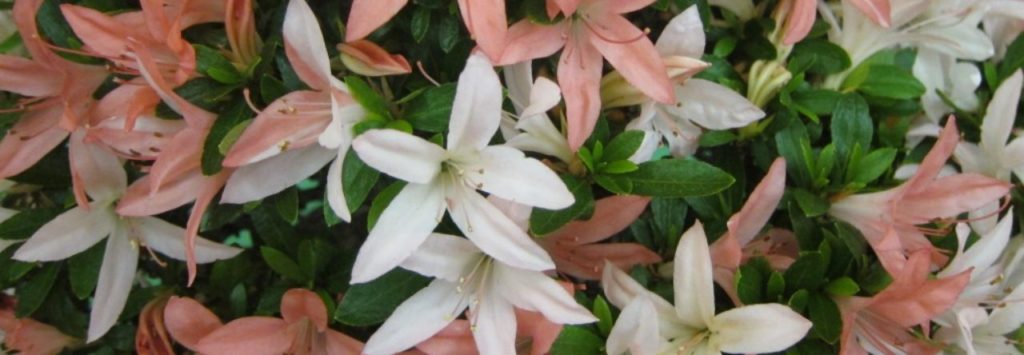
Photo depicts nails above and below grafted branch, sealed with cut paste.

Photo depicts direction of grafted branch and location on trunk.

Photo of Darren Wong, Mike Mello and Marcia Cozens as Darren works on Marcia’s Satsuki azalea bonsai.
On February 23, 2017, at the Bay Area Satsuki Aikokai club meeting, Darren Wong gave the members a demonstration on “approach grafting” of Satsuki azalea bonsai. Approach grafting is the use of two live branches and fusing them together. Darren used a couple of Satsuki azalea bonsai that members brought to the meeting for the purpose of showing how to approach graft. Some preparation was taken in the first case, that was to lightly wire a long branch in the direction of the second branch or trunk. In this case, Darren could easily bend the longer and thinner branch across the trunk. This long, thin branch was the first-year growth and very flexible. He was going to approach graft or attach the longer branch to the trunk. The trunk being thicker than the longer branch. With approach grafting both branches or branch-trunk combination is being fed by the continued flow of water. Approach grafting provides a good and reliable method for a successful union.
The best time for approach grafting is when the bonsai is in the growing season, like February and March.
The cambium plays an important role in approach grafting like other methods of grafting. This is the union that must meet in order to obtain a successful graft.
Darren first determined where on the trunk he needed to add a new branch. He placed the long, thin branch across the trunk and found the location on the trunk to place a new branch. He proceeded to use a sharp grafting knife to make a ¼ inch long “v” shaped cut in the trunk. The “v” is cut length-wise in the direction you want the new branch to grow. The depth of the cut was approximately ½ the thickness of the long, thin branch. The cut was not very deep. Darren pointed out the cambium as green, lying just under the outer bark. This information tells you the branch or trunk is live and capable of taking the approach graft. He used a woodworker’s carving knife to round out the “v” cut for a more natural fitting.
He then placed the long, thin branch into the cut area to ensure a good fit. Darren then used his grafting knife and fingernail to lightly scrape the bark away on the long, thin branch to expose the green cambium layer. This was done on both sides of the long, thin branch so that the cambium of both branch and trunk touched one another. This will help the grafting take faster.
Darren saw that the fit was good. He then used a small nail with rubber washer (imported from Japan) and hammered it in place to hold down the long, thin branch and placing pressure on the union. Another small nail was used to ensure an adequate amount of pressure was placed on the union of branch and trunk. The nails are positioned one above and one below the branch, hammered into the trunk (see photo).
Darren then applied cut paste, rolling the cut paste in his palms to measure about ¼ inch or more in length, and applied the cut paste to all exposed areas of the union. This step is important to seal in moisture and assist in healing the wound.
Approach grafting another member’s bonsai followed the same steps above. Darren cautioned about watering and handling the bonsai afterwards so as not to disturb the approach graft. He did some light cutting of other branches and tips, but do not cut the tip or branch used in the approach graft. The approach graft will be successful when you observe the long, thin branch grow in size. Darren usually leaves the approach graft alone for two years to ensure it takes and is healthy. At that time, you cut at the base where the grafted branch first enters the trunk leaving the new branch.
